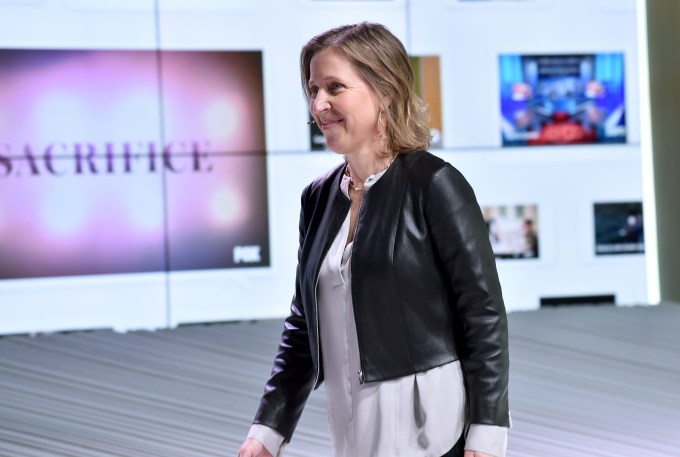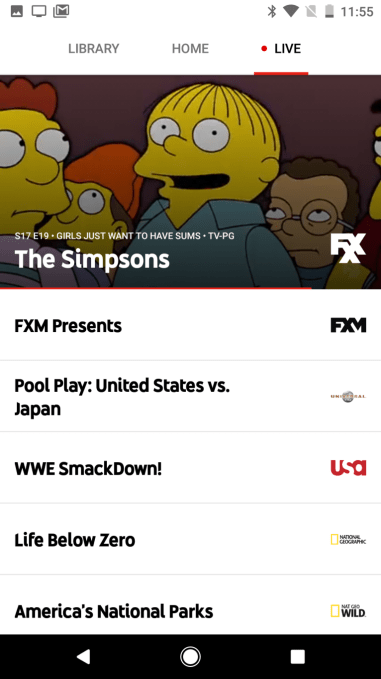
Approximately 2 million people have installed the YouTube TV app, Google’s live TV service aimed at a younger generation of cord cutters, as well as those who never signed up for traditional pay TV in the first place. That download figure comes from app store analytics firms Sensor Tower and App Annie, which both also noted that installs are evenly split between iOS and Android devices.
Of course, 2 million downloads doesn’t necessarily translate into subscribers — many users may have simply installed the app out of curiosity; others could be on free trials that never convert to paid subscriptions.
Still, it’s a number that should give YouTube TV competitors — in particular, telco rivals — pause. YouTube TV is the youngest arrival in the over-the-top live TV space, and it’s growing rapidly.
Sensor Tower said that YouTube TV added about 700,000 new installs of its app since its announcement last week that it was entering several new U.S. markets, tripling its footprint.
Yes, that’s right — YouTube TV has 2 million installs and isn’t even available across all of the U.S. at this point.
That’s a promising start for a newcomer in this race, even if many of those are still trial customers.

That’s not to say YouTube TV is without serious competition.
This April, YouTube TV entered a crowded market, where numerous services compete to deliver live TV to consumers over the internet. Before YouTube TV arrived, Dish’s Sling TV, Sony’s PlayStation Vue and AT&T’s DirecTV Now were battling for cord cutters’ attention. Following the launch of YouTube TV, Hulu rolled out its own Live TV service. And this week, Comcast said its Xfinity Instant TV service could hit the U.S. before the end of the year.
The live TV rivals
Dish’s Sling TV live TV service has been around the longest, allowing it to move quickly into new areas — as it recently did with pay-per-view. Its service has more than 2 million subscribers, according to comScore’s latest report, released last month.
AT&T, meanwhile, can push DirecTV Now on its wireless customers by offering deals, and Sony can market Vue to its millions of PlayStation users. But Vue and DirecTV Now combined only have 1.1 million subscribers, says comScore. (Separately, AT&T announced this week DirecTV Now was nearing half a million subscribers.)
Then there’s Hulu, whose brand is well-known to consumers who think of it as a place to watch the broadcast and cable TV shows Netflix doesn’t offer. Hulu can upsell live TV to its existing customers. While the company doesn’t release subscriber figures, it said in May it had 47 million total unique viewers. (comScore didn’t release numbers for Hulu, YouTube TV or FuboTV.)
YouTube TV’s advantages
For the telcos, in particular, the streaming market is a tough business. As AT&T and Dish’s earnings have revealed, these newer internet TV services aren’t able to onboard customers fast enough to offset the losses from those dropping residential pay TV subscriptions.
For instance, AT&T in its most recent quarter lost a record number of traditional TV subscribers, and while DirecTV Now “helped” offset those losses, it couldn’t close the gap.
But for YouTube, there’s no legacy TV biz to shore up. It can move into the space freely, without worrying much about the slim margins of its low-cost $35 per month subscription offering. And its margins could be very slim, indeed. One analyst had estimated that $29 per month of affiliate fees would eat up the $35 subscription, before regional sports networks came in, adding $4 to $5 more.
Or, in other words, YouTube TV would be an ad-supported business.
Good thing for YouTube, then, that its user base grew up watching ads alongside their videos.
 Though an optional YouTube Red subscription can remove those ads across regular YouTube, the mere existence of ads on YouTube TV — (and they’re everywhere — live, on-demand, DVR, etc.) — won’t necessarily be a deal breaker for the live TV service’s subscribers.
Though an optional YouTube Red subscription can remove those ads across regular YouTube, the mere existence of ads on YouTube TV — (and they’re everywhere — live, on-demand, DVR, etc.) — won’t necessarily be a deal breaker for the live TV service’s subscribers.YouTube also has the benefit of selling TV to an existing and massive user base. The company announced in June it had grown to 1.5 billion logged-in monthly viewers. (YouTube doesn’t break out its U.S. monthly viewer numbers, but eMarketer says 185.9 million.)
Plus, YouTube TV has original content of its own, catering to its young viewers. Its 37 original programs, which are included with both YouTube TV and the ad-free paid subscription, YouTube Red, have now generated nearly 250 million views.
Also worth noting, YouTube itself appeals to the next generation of “TV” viewers — the kids who know their favorite YouTube stars better than they do Hollywood A-listers.
YouTube doesn’t have to convince these kids to cut the cord in favor of YouTube — they never planned to buy the cord in the first place.
Sensor Tower’s figures for YouTube TV — 2 million downloads, 50/50 split — were also confirmed by App Annie, which added that if time spent in the YouTube Kids app is any indication, then YouTube TV should do well among streaming apps for user engagement. YouTube TV may be in its infancy, but its download levels show significant traction, App Annie said.
YouTube Kids launched in 2015 and now ranks No. 7 by total time spent among Entertainment apps, as of June 2017 on Android phones in the U.S., behind giants like Netflix, Hulu and Amazon Prime Video.
Meanwhile, YouTube itself is No. 3 out of overall apps for time spent on Android phones in the U.S. — or nearly 17 times the average total time spent of the next three highest ranking video streaming apps, said App Annie.
Reached for comment, YouTube declined to confirm the new download numbers
More@ https://www.technapping.com
Source: Techcrunch
Comments
Post a Comment